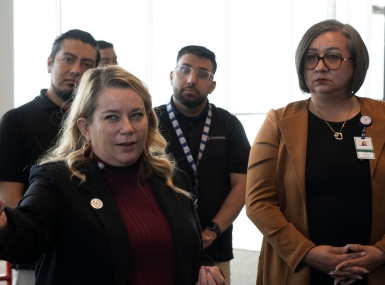Food Insecurity: Finding Homegrown Solutions
Key Takeaways
The single biggest factor impacting your health today isn’t something you’ll find in a DNA kit or even during a routine physical. The answer is much closer to home. According to the CDC, a person’s ZIP code is a greater predictor of their health and life expectancy than other factors, including genetics.
Access to healthy food, public safety and environmental factors are all part of the story and are more visible to a person’s local county officials than their doctor. These factors are called social determinants of health (SDOH); they are becoming increasingly influential to our health as individuals and as communities.
At the Aetna Foundation, one determinant we are focused heavily on is increasing access to healthy foods. Ensuring easy access to farmers’ markets and community gardens and making it easier for people to get to their local grocery story can help lower health issues related to obesity, such as diabetes.
While many of us are lucky enough to have full pantries and fridges, a large portion of the country is not as fortunate. More than 23 million Americans, including 6.5 million children, live in food deserts — places where fresh fruit and vegetables (and healthy foods in general) are largely inaccessible. A significant percentage of this group lives in low-income neighborhoods, both urban and rural.
This is a national problem, but the solutions are unique to each community and are growing in our own backyards. Through the Healthiest Cities & Counties Challenge, a partnership between the Aetna Foundation, the American Public Health Association and the National Association of Counties, we’re empowering local communities to solve the most pressing issues impacting their societies.
Most recently, our organizations recognized 15 communities making a particularly hard-hitting impact — several of which are working to fight nutrition issues and food insecurity. For example, in Waco-McClennan County, Texas, the county is helping increase access to healthy foods through a non-profit grocery store in an identified food desert. Together, they’re bringing fresh foods to underserved communities through a “Veggie Van” and hosting workshops at the Waco Downtown Farmer’s Market to pique interest in healthy food options.
In Leon County, Fla., the iGrow Food Network donated more than 100 pounds of fresh produce within a 60-day period, involved youth in summer camps and have reached more than 200 households in designated food desert areas.
Access to healthy food remains a pressing issue when it comes to determining the health of individuals and communities. We all have a role to play in combating the negative social determinants of health impacting individuals living in our cities and counties. Through our work with NACo, we are seeing that the best solutions to food insecurity are growing in our own backyards — in counties across the country.
Attachments
Related News

L.A. County fends off homelessness with an assist from A.I.
A predictive model pulls data from six county departments to create a list of the county’s most vulnerable population — people who frequently show up in the county’s criminal justice and hospital systems and who access benefits like SNAP.

El Paso County, Texas helps migrants on their way
Though they don't often stay more than a day, asylum seekers receive care and services from El Paso County, Texas before they leave for their next destination.

